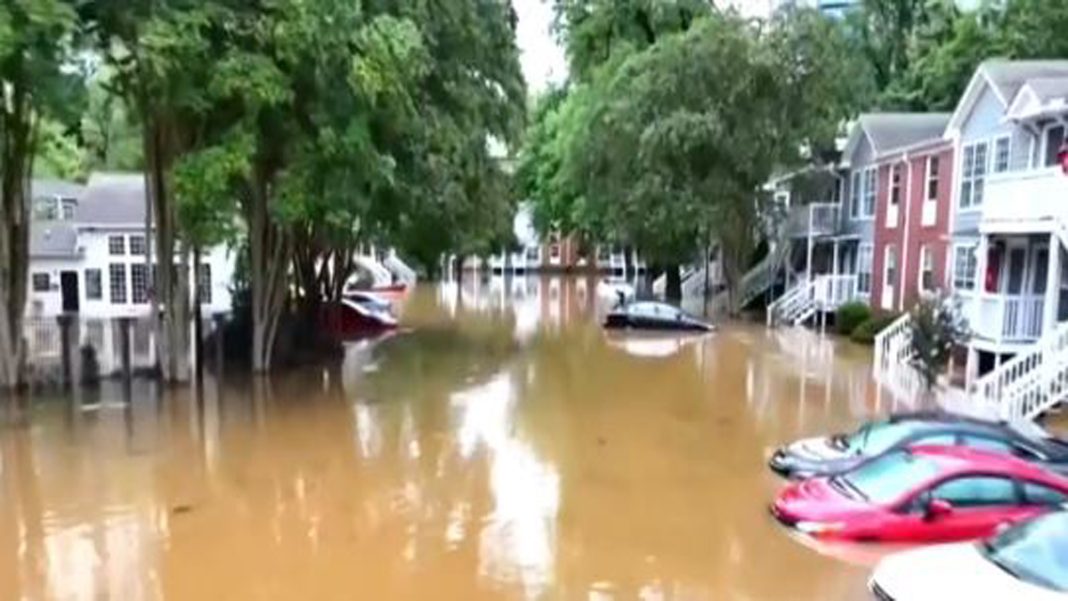As Hurricane Helene battered the southeastern United States, it left behind a trail of devastation that would be felt for years to come. Making landfall as a Category 4 hurricane with winds reaching an astonishing 140 mph, Helene struck the Big Bend region of Florida late Thursday, unleashing torrential rains that would provoke catastrophic flooding across several states. The aftermath has been described by residents and officials alike as unprecedented, with a growing toll of at least 56 fatalities reported, alongside widespread destruction and millions left without power.
In the heart of Florida, Janalea England, a resident of Steinhatchee—a small fishing town—transformed her commercial fish market into a donation center for those left homeless. “I’ve never seen so many people homeless as what I have right now,” England remarked, reflecting the dire situation in her community. Many locals found themselves unable to secure insurance on their properties, leaving them vulnerable and dependent on the generosity of neighbors amid the chaos.
As the storm swept through Georgia, Governor Brian Kemp surveyed the wreckage from above, likening the scene to a war zone. “It looks like a bomb went off,” he stated, surveying splintered homes and debris-laden highways. This was not just a local disaster; it was a regional crisis, as Helene continued to drench the Carolinas and Tennessee, causing rivers to overflow and leading to significant infrastructural damage. Western North Carolina, in particular, faced isolation due to landslides that closed major highways, including Interstate 40, while numerous rescues were conducted, many of them dramatic. In Unicoi County, East Tennessee, helicopters were deployed to evacuate hospital patients stranded on rooftops.
The volume of rainfall was staggering; Spruce Pine, North Carolina, recorded over two feet of rain within just a few days. In Atlanta, the city experienced its highest rainfall in 145 years, with over 11 inches falling within a mere 48 hours. Such extreme weather events have led experts to draw connections between climate change and the increasing intensity of hurricanes. According to a study by the National Oceanic and Atmospheric Administration, rising ocean temperatures are fueling the rapid intensification of tropical storms, making them more destructive than ever before.
President Joe Biden has described the devastation as “overwhelming” and pledged federal support for recovery efforts. The financial implications are equally staggering, with Moody’s Analytics estimating property damage between $15 billion to $26 billion, while AccuWeather anticipates total losses could reach as high as $110 billion. This stark economic reality serves as a reminder of the vulnerabilities many communities face in the wake of natural disasters, particularly in regions that have historically been less prone to such catastrophic weather events.
The human toll of Helene’s fury was felt acutely, with reports of drownings in mandatory evacuation zones and families desperately trying to locate missing loved ones. Francine Cavanaugh, anxiously awaiting news from her sister, noted, “I think that people are just completely stuck.” As emergency services struggled against downed power lines and communication breakdowns, the sense of isolation deepened for many residents.
As the storm transitioned into a post-tropical cyclone, its remnants continued to linger over the Tennessee Valley, prolonging the suffering for those already impacted. The ongoing threat of flooding and the strain on emergency services highlight the urgent need for improved infrastructure and disaster preparedness in the face of increasingly severe weather patterns.
In the wake of such disasters, communities often come together to support one another, a testament to human resilience in the face of adversity. Yet, as John Berg, a long-time resident of Steinhatchee, poignantly stated, “It’s bringing everybody to reality about what this is now with disasters.” The reality is that climate change is not just a distant concern—it is very much a present danger, shaping our weather patterns, our economies, and ultimately, our lives.
As recovery efforts progress, the stories of those deeply affected by Hurricane Helene will serve as crucial reminders of the need for comprehensive strategies to mitigate the impacts of future storms. The journey to recovery may be long, but it is through the collective strength of communities that hope will rise amid the devastation.


